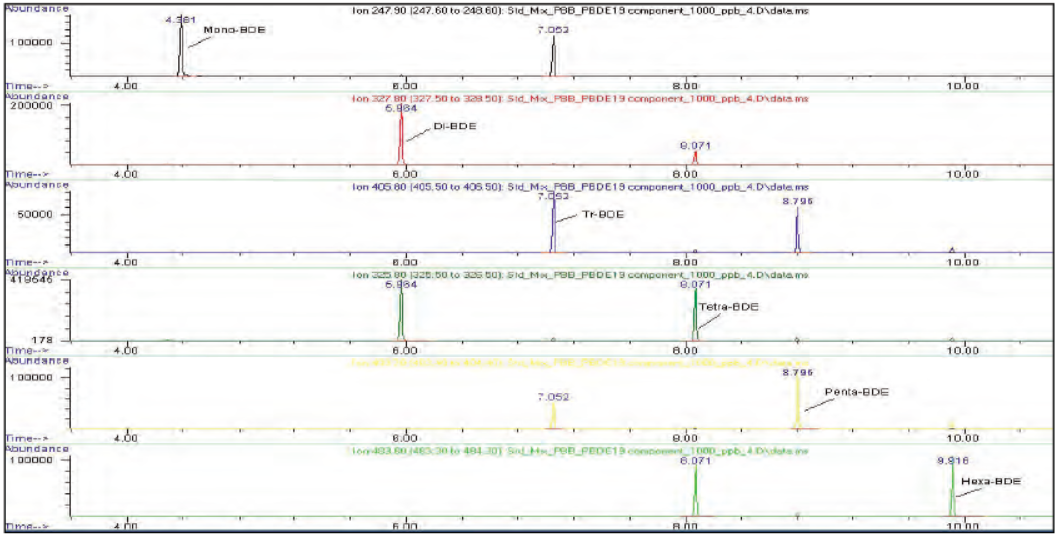Quantitative analysis of PBBs and PBDEs in plastic parts of electrical and electronics equipment according to RoHS regulation by gas chromatography/mass spectrometry
DOI:
https://doi.org/10.60136/bas.v3.2014.192Keywords:
PBBs, PBDEs, plastic, gas chromatography/ mass spectrometryAbstract
A test method has been developed in this research for quantitative analysis of polybrominated biphenyls (PBBs) and polybrominated diphenyl ethers (PBDEs) in various plastics, including acrylonitrilebutadiene–styrene, polypropylene, polyethylene, high-impact polystyrene and polyethylene terephthalate plastics based on the solvent extraction of the sample with soxhlet extraction technique and detection by gas chromatography/mass spectrometry. It was found that the test method was able to quantitate monobrominated- decabrominated biphenyl and monobrominated diphenyl ether–nonabrominated diphenyl ether between 100-1,750 mg/kg and decabrominated diphenyl ether between 100–8,000 mg/kg. The limit of detection (LOD) was between 3.9-25.5mg/kg. The limit of quantitation (LOQ) was between 13.1-85.0 mg/kg. The precision of the method expressed as percentage relative standard deviation was between 1.8 and 10.2, except 17.0 for BB-209 at lowest concentration (100 mg/kg). The accuracy of the method expressed as percentage recovery was between 80.9 and 116.8, except 130.1 for BDE-047 at lowest concentration (100 mg/kg). The obtained accuracy and precision of the method therefore meet the required accuracy expressed as % recovery which is between 70-130% and the required precision expressed as percentage relative standard deviation which is less than 20%RSD of the IEC 62321:2008 international standard method.
References
Directive on the restriction of the use of certain hazardous substances in electrical and electronic equipment (RoHS) 2002/95/EC. Official Journal of the European Union, 2003.
SCHLUMMER, M., et al. Characterization of polymer fractions from waste elctrical and elctronic equipment (WEEE) and implications for waste management, Chemosphere, 2007, 67(9), 1866-1876.
ALTWAIG, A., M. WOLF., and R. van ELDIK. Extraction of brominated flame retardants from polymeric waste material using different solvents and supercritical carbon dioxide, Analytica Chimica Acta, 2003, 491(1), 111-123.
HUBER, S., and K. BALLSCHMITER, Characterization of five technical mixtures of brominated flame retardants, Fresenius Journal of Analytical Chemistry, 2001, 371, 882-890.
IEC 62321: 2008, Edition 1.0, International Standard: Electrotechnical products- Determination of levels of six regulated substances (lead, mercury, cadmium, hexavalent chromium, polybrominated biphenyls, polybrominated diphenyl ethers), 2008.
KEMMLEIN, S., D. HERZKE., and R. J. LAW. Brominated flame retardants in the European chemicals policy of REACH — Regulation and determination in material, Journal of Chromatography A, 2009, 1216(3), 320-333.
WU, H. Q., et al. Determination of polybrominated diphenyl ethers and polybrominated
biphenyls in electrical and electronic equipment by gas chromatography-mass spectrometry, Chinese Journal of Analytical Chemistry, 2007, 35(3), 325-329.
EBERT, J., and M. BAHADIR, Formation of PBDD/F from flame-retarded plastic materials under thermal stress, Environment International, 2003, 29(6), 711-716.
BOER, J. C. P. Capillary gas chromatography for the determination of halogenated micro-contaminants, Journal of Chromatography A, 1999, 843, 179-198.
BJÖRKLUND, J., et al. Influence of the Injection Technique and the column system on gas chromatographic determination of polybrominated diphenyl ethers, Journal of Chromatography A, 2004, 1041(1-2), 201-210.
COVACI, A., et al. Recent developments in the analysis of brominated natural compounds, Journal of Chromatography A, 2007, 1153(1-2), 145-171.
SCHLUMMER, M., et al. Characterisation of polymer fractions from waste electrical and electronic equipment (WEEE) and implications for waste management, Chemosphere, 2007, 67(9), 1866-1876.
SCHLUMMER, M., et al. Analysis of flame retardant additives in polymer fractions of waste of electric and elctronic equipment (WEEE) by means of HPLC-UV/MS and GPC-HPLC-UV, Journal of Chromatography, 2005, 1064(1), 39-51.
STAPLETON, H. M. Instrumental methods and challenges in quantifying polybrominated diphenyl ethers in environmental extracts: a review, Analytical Bioanalytical Chemistry, 2006, 386(4), 807-817.
VONDERHEIDE, A. P. A review of the challenges in the chemical analysis of the polybrominated diphneyl ethers, Microchemical Journal, 2009, 92(1), 49-57.
KORYTÄR, P., et al. Comprehensive two-dimensional gas chromatography of polybrominated diphenyl ethers, Journal of Chromatography A, 2005, 1100(2), 200-207.

Downloads
Published
How to Cite
Issue
Section
License
Copyright (c) 2022 Bulletin of Applied Sciences

This work is licensed under a Creative Commons Attribution-NonCommercial-NoDerivatives 4.0 International License.









